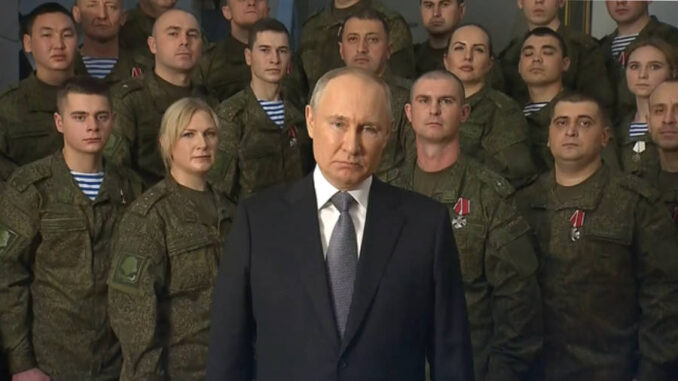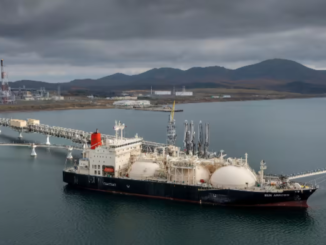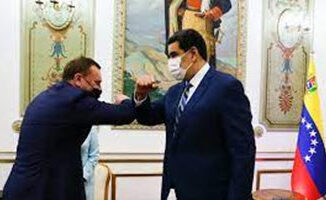
The Russian President, Vladimir Putin, gave his annual New Year address on Russian State TV on the evening of December 31st from frontlines with Ukraine, in an extended speech – the longest of his Presidency. That can be seen (with English subtitles) here with Russian military standing behind him. As often with such speeches, they can tend to be light on real content, and especially as 2022 turned the corner in a New Year, President Putin was not going to be too downbeat. Russian Christmas, a Holy time in the Orthodox calendar, symbolizing rebirth, is on January 7th. Nonetheless, Putin did state that “It was a year of difficult, necessary decisions, major steps towards gaining the full sovereignty of Russia and the powerful consolidation of our society. The truly pivotal, fateful events of 2022 have become a milestone laying the foundation for the common future of Russians and our true independence. This is what we are fighting for today.”
This is a direct reference to the charges of ‘unipolarity’ laid by Russia – and notably China, amongst many others that have accused Western powers of creating a global society based upon their own rules. Often referred to as a ‘rules-based order’ – this is seen elsewhere as rules set down by the Wests leading economies and that are designed to impose their version of order and rules upon the rest of the world – to the West’s exclusive benefit – and including the support of conflict to impose such an order.
In many minds, Putin has a point. The global SWIFT banking network, originally designed as a global tool to prevent money-laundering and drug smuggling, has become a political weapon used to disconnect Iranian and Russian banks from the international financial system. It has ceased to be truly multilateral and now acts at the behest of Washington.
Imposing trade sanctions and tariffs upon other countries has become a modus operandi for the West to use against developing nations, including Russia during 2022 – and China from 2018, and still ongoing to inhibit Chinese tech developments. In fact, there is supposed to be a global trade mechanism – the World Trade Organisation (WTO) to debate such matters. It too, has been circumnavigated and largely rendered obsolete. The United States unilaterally now imposes sanctions – and threatens other countries with secondary sanctions if they do not follow its ‘rules.’
Even the global legal framework has been shoved to one side – the United States and EU have been freezing assets of other countries held in their banks and financial institutions. Even the much-abused Afghanistan, in dire need of finance to rebuild its economy, has had its sovereign assets in the form of gold, stored in the US for safekeeping, taken to compensate victims of 9-11. That money however belonged to the Afghanistan people. As for Russia, Oligarchs, Politicians and Businesses have had bank accounts frozen, property and yachts seized, all without the need to argue any of this in court or debate the legalities. Impartial examination and the rule of law, leading to analyzed merits of any judgement concerning seizure of property being simply discarded.
I am no fan of the super-rich, but even they should have the right to challenge charges laid against them in a court of law. That basic protection, a cornerstone of democracy, has been removed. This does not constitute ‘rule of law’. Let’s call this for what it really is: State Sanctioned Theft.
Readers of course may point to the Ukraine conflict for the reason for this happening. But if there wasn’t such a conflict, what then? The power to inflict such punishments obviously exists. Putin has called attention to this – and referred to the loss of sovereignty this implies. For example, in a little-known move last week, Kazakhstan was ‘given permission’ by the United States Treasury Department’s Office of Foreign Assets Control (OFAC) to conduct debit card payments with Russia. That is a loss of sovereignty. Trade between two neighboring countries now requires US permission. These are the issues Putin is referring too.
Concerning the Ukraine conflict itself, Putin stated that “The West has been lying about peace for years, but in fact it was preparing for aggression. And today it is openly admitting this, no longer embarrassed. They are cynically using Ukraine and its people to weaken and split Russia. The Western elites hypocritically assured of their peaceful intentions, including the settlement of the conflict in the Donbass, but in fact “in every possible way encouraged the opposite”.
This is a reference to the Minsk accords, agreed to by Russia and Ukraine, brokered by France, Germany, and the Organization for Security and Co-operation in Europe (OSCE) in 2014. These agreements were to uphold the rights of ethnic Russians in the Donbass region of Ukraine, granting them the ability to use their own language, and a degree of self-governance in the wake of what had been aggression against ethnic Russians in these regions. The conflict should have stopped there – however Kiev never properly upheld them, while the OSCE did little to enforce them. What has subsequently emerged is that the then leaders of France (Hollande) and Germany (Merkel) had no intention of following through with the agreements – and had brokered them purely to give Ukraine time to build up its military. It means that Europe lied to Russia about the real intent of the Minsk accords from the very beginning – and Moscow bought it.
Putin completed his speech by saying that “The most important thing is the fate of Russia, its defence is a sacred duty to ancestors and descendants. We have always known, and today we are again convinced that the sovereign, independent, secure future of Russia depends only on us, on our strength and will. Russia’s struggle for its interests and its future will become an inspiring example for other states in their striving for a fair multipolar world order, and Russians must believe that their country will remain great and independent and will only move forward and win.”
There are fundamental differences here between how Russia views the Ukraine conflict and how the West has positioned it. Russia believes it is being threatened – the West says that Russia is being threatening. The answer to this contradiction is complex, however lies in the question of NATO membership for Ukraine. US President Biden had refused to confirm that Kiev would not join NATO and stated in December 2021 that “Kiev’s bid to join the NATO military alliance was in its own hands, and that “the country is free to choose to join NATO without interference from other nations.”
This issue here is that rightly or wrongly, Moscow was of the opinion that NATO had agreed back in 1991 that it would not expand eastwards. The truth of this is buried amongst denials on both sides – however its seems that the position at best was deliberately made ambiguous to allow the United States to illustrate that was the intention, without ever actually confirming it. Since 1991, NATO has expanded from 17 countries to 30 today. It is almost unthinkable that NATO could not see that a continuation of this push east would eventually provoke Moscow. It has done, with the Ukrainian border with Russia just 400km distant from the Russian capital. Technical advances have meant that today, hypersonic missiles could be capable of hitting Moscow in a matter of a few minutes, far too close for Putin’s liking, and understandably so. This is why Putin states that it is Russia who feels threatened.
There are other motivations. In creating conflict in Ukraine, the United States has effectively removed Russia as the main supplier of energy to Europe – substituting to a large degree its own energy supplies instead, a 137% LNG gas supply increase in 2022 over 2021 and a multi-billion-dollar windfall for US energy companies. Additionally, US arms sales to NATO nearly doubled during 2022 – another financial windfall. The truth about the Ukraine conflict is actually that it has many motivations, with the majority of these being financially rewarding – for Washington.
What Next For Russia in 2023?

Putin’s speech didn’t tell us much about expectations for the new year, although in a separate address last week, Russian First Deputy Prime Minister Andrey Belousov stated that “We believe that 2023, if nothing happens, will naturally be much easier than 2022: we don’t see any fatal problems there. Of course, next year we will not be able to show 3% GDP growth, most likely it will be lower. I think it will be around zero.”
While not brilliant by any stretch of the imagination, it does mean that Russia is not expected to enter recession in 2023 – which cannot be said for the Western economies. In terms of inflation, Russia’s Ministry of Economic Development assumes that inflation in Russia in 2023 will be 5.5%. Again, not brilliant but better than projected for much of Europe.
Why? It’s all about the energy costs – Russia has plenty of cheap energy and this will support its productivity. The Russian Purchasing Managers Index in December was 6 points higher than that of the EU – where in contrast, energy costs have become far more expensive – hindering EU productivity and leading to reports that EU manufacturing may relocate to the United States in another win for Washington – at the expense of Brussels and the Eurozone economy.
In terms of encouraging trade and investment, 2022 was a year which forced Russian businesses to look to the East, a push that President Putin has been advocating for years. Notoriously conservative, Russian MNCs and entrepreneurs are now reaching out to Asia. Trade with China and India has skyrocketed, with energy leading the way but also paving the way for additional products – agriculture especially. With two of the world’s most populated countries – a combined count of close to 3 billion people – hungry for both energy and food, Russia has already overcome its reliance on the European Union market – and its static population of 447 million. Do the math – China and India’s middle class populations are both set to grow over the next decade – China’s CPC 5 year plan, released in October after the National People’s Congress was clear in its objectives as concerns trade. It is continuing its policy of developing and encouraging wealth creation within its middle class and is aiming for more than a doubling of that between now and 2035. That means 800 million middle class Chinese in a little over a decade.
As for India, 31% of the total Indian population today, or about 500 million people are considered to middle class standard, a figure that by 2047, if political and economic reforms have their desired effect, indicates that the Indian income pyramid will have a smallish layer at the bottom, a huge bulge of the middle class and a big creamy ‘rich’ layer on top” according to Rajesh Shukla, CEO of People Research on India’s Consumer Economy (PRICE). Put another way, Russia in 2022 has been investing in fast growing consumer economies of a considerably larger size than its now sanctioned, largely off-limits markets in the EU and United States.
It’s not just China and India. Trade blocs closer to home that include Russia are also showing development. Russia’s trade with the Commonwealth of Independent States (CIS) is also up, in a grouping that includes Armenia, Azerbaijan, Belarus, Kazakhstan, Kyrgyzstan, Moldova, Russia, Tajikistan and Uzbekistan. The more formal, and better trade integrated Eurasian Economic Union (EAEU), which includes Armenia, Belarus, Kazakhstan, Kyrgyzstan and Russia also has Free Trade Partners with Iran, Serbia, Vietnam and China, has also increased its trade volumes.
Then there are the BRICS – Brazil, Russia, India, China and South Africa. BRICS trade is also significantly increasing with a further 13 nations poised to join. If accepted, the new proposed BRICS members would create an entity with a GDP 30% larger than the United States, possessing over 50% of the global population and in control of 60% of global gas reserves.
These create huge logistical problems for the United States and European Union in terms of maintaining sanctions punishment upon Russia. The basic facts are that Moscow is simply just conducting its trade elsewhere.
Trade Finance

There will be developments in terms of global finance and payment mechanisms during 2023, with significant implications for the US dollar and the Euro. The ‘de-dollarisation’ concept has now spread to the Euro after both currencies have been restricted from use by Russia. This has meant that Moscow is building alternative currency relations with numerous countries, including trading with the Chinese Yuan and Indian Rupee as alternatives. Other currencies are currently being assessed for use in a new basket of tradable money, including the UAE Dirham, and currencies from the EAEU and CIS blocs. By the end of 2023, use of US dollar and Euro in Russian trade will be in the considerable minority. Depending upon the success of this, and the continuing use of secondary sanctions threats by Washington on third party nations, the move away from USD and Euro use may have far reaching implications should more countries adopt these measures.
Russia however has another ace up its sleeve – cryptocurrency. Use of what will be Russian state-controlled crypto mechanisms are expected to be launched in Q2 2023, with crypto exchanges being established. That will mean that businesses and individuals can purchase crypto currencies in USD or Euro for example in say New York, Berlin, or Singapore, and wire these to exchanges in Russia where they can be exchanged for Rubles. The West will surely look at preventing this – maybe by criminializing the sending of assets to Russia – but this would again leave them open to accusations of ‘big brotherly’ tactics, and encourage the use of third-party exchanges elsewhere anyway. Meanwhile, the operational crypto mechanism is almost certainly foolproof and financially intact, while the Digital Ruble is set to have a pilot launch in April.
These new trade finance mechanisms will push Russia into becoming a global leader in processing digital financial assets. In contrast, the digital dollar is years away.
Ukraine

The bigger question is the end to the Ukraine conflict, of which much has been written. Most commentary concerning this has failed to understand the depth of Russia’s resources, while the mantra ‘Russia is losing the war’ has been repeated so often and for so many months now it has reached a level of absurdity: Russia is clearly not losing the Ukraine conflict. But neither is it winning, either, at least not until a settlement can be reached. How long that takes will be influenced by several issues: Resentment from the United States and European Union over the financial cost of propping the country up – Ukraine is estimated to have a US$38 billion budget shortfall for 2023 that will require funding – even before military and other costs are factored in. EU nations and their citizens will soon be asking why their leaders are spending so much money on a non-EU, essentially bankrupt nation while their own economies tread into recession.
Energy will be a large factor, with EU manufacturing and productivity in decline due to increased costs. Volkswagen’s CEO stated in November that ‘Europe is not cost-competitive in many areas.’ Should this winter – which will not be over until early April – prove demanding, and EU nationals subjected to power cuts, the political ability for Brussels to keep its course will diminish. It should also be remembered that it was EU politicians, not Russian who acted to turn off the Nordstream supplies – while the underwater explosions that knocked out part of the pipelines have still not been adequately explained.
The underlying trends therefore all point to a Russian success in eventually obtaining what it wanted all along – national security. How this would be explained to EU nationals is Brussels current political dilemma. As for Washington, they have already won. The United States has sold double the weapons it previously did to NATO in less than a year, while it has secured the European Union as an energy customer for decades.
For Russia though, the fundamentals point to an eventual buffer being brokered against the EU and lessons learned by the West – don’t go sticking forks into sleeping bears. When that lesson is finally absorbed, life in Ukraine can return to peace. However – Ukraine will not be the country that it once was – those days are over. The best Kiev can hope for is a semblance of neutrality in a conflict it should never have been politically encouraged to engage in from the start. The EU meanwhile will have to pick up the pieces of an economy fundamentally damaged by rather higher energy costs, while Russia is more likely to pull competitively ahead in Asia. 2023 is poised to illustrate how deep these trends will be.



